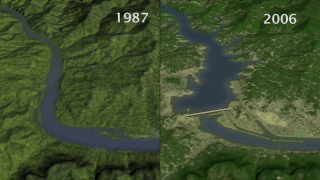Environmental, safety concerns mount over China’s Three Gorges Dam
Environmental, safety concerns mount over China’s Three Gorges Dam
mongabay.com
August 29, 2007
|
|
Environmental problems are worse than anticipated at China’s massive Three Gorges Dam, reports the The Wall Street Journal. A year after its completion, there are rising concerns of pollution, landslides, and flooding.
Geologists say the weight of five trillion gallons of water trapped behind the dam is causing the steep shores of the Yangtze to erode, triggering landslides and reducing ground stability. Runoff, sewage, and industrial pollution is collecting in the dam’s reservoir turning it into a toxic soup that threatens agriculture and water supplies. Further, by blocking silt headed downstream, the dam is choking the Yangtze River estuary region — which includes Shanghai — causing it to shrink. Higher flow rates are damaging downstream dikes used for flood control.
“We thought of all the possible issues,” environmental scientist Weng Lida, secretary general of the Yangtze River Forum, a coalition of the Chinese government and nongovernmental organizations, told the The Wall Street Journal. “But the problems are all more serious than we expected.”
Some experts warn that $22 billion dam could worsen the very floods it was build to control.
 NASA animation of the dam |
“Past the narrow gorges where it enters central China’s broad plains, the river traditionally slowed, and in some places centuries of sedimentation raised the riverbed above the surrounding countryside and is held back by dikes, as in New Orleans,” writes Shai Oster. “Water released by Three Gorges runs faster, the WWF says, because the dam traps most of the silt. Lightened of its muddy load, the water courses out with more force and threatens to gouge out these dikes.”
Oster notes that the dam has long been controversial.
“From the late 1950s, the government approved and then delayed construction of a dam here several times, hobbled by technical challenges. By the late 1980s, China also faced mounting charges that a dam and reservoir would force mass relocations and destroy archeological sites and temples,” he writes. “In 1992… the dam project was put to a vote before the National People’s Congress. It passed. But nearly one-third of China’s usually docile legislature voted no or abstained, an unusual show of dissent. Construction officially began in 1994. Controversy continued. Responding to pressure from human-rights groups, the U.S. government and the World Bank pulled support from the project. In an open letter in 2000, leading engineers in China, including some who had worked on the feasibility study, protested a decision to fill the reservoir faster than originally planned.”
Shai Oster (2007). In China, New Risks Emerge At Giant Three Gorges Dam. The Wall Street Journal. August 29, 2007; Page A1
Related
NASA monitors China’s Three Gorges Dam.
Some call it the eighth wonder of world. Others say it’s the next Great Wall of China. Upon completion in 2009, the Three Gorges Dam along China’s Yangtze River will be the world’s largest hydroelectric power generator and one of the few man-made structures so enormous that it’s actually visible to the naked eye from space. NASA’s Landsat satellites have provided detailed, vivid views of the dam since construction began in 1994. The Yangtze River is the third largest river in the world, stretching more than 3,900 miles across China before reaching its mouth near Shanghai.